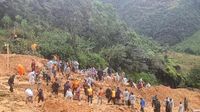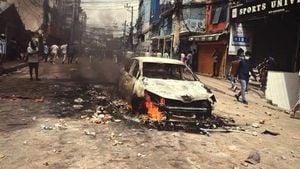In the early hours of September 30, 2025, a devastating landslide struck the quiet village of Ma Lau A in Lũng Cú commune, Tuyên Quang province, Vietnam, forever altering the lives of its residents. The incident, which occurred just after dawn at approximately 6:30 AM, saw a section of hillside several dozen meters high collapse, burying six homes and trapping four members of a single family beneath tons of earth and debris. The scene was chaotic and heart-wrenching, as neighbors and local officials rushed to the site, desperate to help.
According to Dân trí, the gravity of the situation quickly became apparent. The landslide had not only claimed lives but also left a trail of destruction across the community. As word of the disaster spread, rescue efforts were mobilized with impressive speed and scale. About 200 people, including police officers, local military personnel, border guards, forestry officials, and villagers, converged on Ma Lau A to join the search. The Tuyên Quang Border Guard even deployed two trained service dogs to bolster the operation, highlighting the seriousness of the mission and the hope that survivors might still be found.
Yet, the rescue teams faced formidable challenges. Heavy rain continued to pound the area, causing the unstable terrain to shift further and hampering every effort to reach those buried. Slippery mud, relentless downpours, and the constant threat of additional landslides made the operation perilous. As Kinhtedothi reported, more than two days passed with no sign of the missing family members. The community waited in anxious silence, clinging to hope as the search dragged on.
Finally, on the morning of October 2, 2025, a breakthrough came. At approximately 10:14 AM, rescue workers discovered the body of Mrs. Hầu Thị Dính, the first victim recovered from the disaster. The find was bittersweet—relief that at least one loved one could be returned to her family, but sorrow over the loss and the grim reality that three others remained missing beneath the rubble. As reported by the local authorities and covered by Dân trí, the body was promptly handed over to Mrs. Dính's family, allowing them to perform funeral rites in accordance with local customs—a small comfort in the midst of tragedy.
Mr. Trần Văn Chung, Chairman of the People’s Committee of Lũng Cú commune, told Dân trí, "To search for the victims, the authorities mobilized about 200 people. In addition, the Tuyên Quang Border Guard also brought two service dogs to the scene to assist in finding the victims." His words reflect the collective determination that characterized the rescue effort, a testament to the strength and unity of the community in the face of disaster.
The landslide had struck the home of Mr. Vàng Chá Sò, leaving his family at the center of the tragedy. According to reporting by the local press, the sheer volume of earth and rocks that had cascaded down from the hillside made the rescue mission especially daunting. Despite the best efforts of all involved, the dangerous conditions—marked by ongoing rain, unstable ground, and the looming threat of further landslides—meant that progress was slow and fraught with risk.
Local officials and volunteers worked tirelessly, often in hazardous conditions, to recover the missing. The sense of urgency was palpable. As one rescue worker remarked to Kinhtedothi, "Despite the large amount of soil and rocks that had collapsed and unfavorable weather conditions, rescue work faced many difficulties." The community, meanwhile, rallied around the affected family, offering support and encouragement as they endured the agonizing wait for news of their loved ones.
The tragedy in Ma Lau A was not an isolated incident. By 9 AM on October 2, 2025, the combined effects of landslides and floods across Tuyên Quang province had resulted in six deaths or missing persons, according to statistics provided by the provincial authorities and reported by Dân trí. Nearly 6,400 households had been affected, with damage extending to 50 schools and health stations. The agricultural toll was also severe—7,000 hectares of rice and corn fields lay submerged or buried under mud and debris, threatening the livelihoods of countless families in the region.
In the aftermath of the disaster, local authorities have been quick to respond. Efforts are underway to support and encourage the families affected, and to implement safety measures for those living in areas at risk of further landslides. As stated by officials to the press, "Local authorities are actively supporting and encouraging the families of the victims, while continuing to implement safety measures for residents in landslide-prone areas." This commitment to both immediate relief and long-term prevention reflects a growing recognition of the dangers posed by extreme weather and unstable terrain in the region.
For the residents of Lũng Cú, the tragedy has been a stark reminder of the unpredictability of nature and the vulnerability of those living in mountainous, rural areas. Landslides are not uncommon in northern Vietnam, particularly during the rainy season, but the scale and suddenness of the Ma Lau A incident have left a lasting impression on all who witnessed it. The outpouring of support from across the province—evident in the sheer number of people who joined the search and the resources deployed—speaks volumes about the resilience and solidarity of the community.
As rescue operations continue, the focus remains on recovering the remaining victims and preventing further loss of life. The authorities have urged residents in high-risk zones to remain vigilant, particularly as heavy rains persist and the risk of additional landslides lingers. Meanwhile, the families affected by the disaster are left to mourn and rebuild, supported by neighbors, officials, and the broader Tuyên Quang community.
In Ma Lau A, the scars of the landslide are visible in the landscape and in the hearts of those who call the village home. The story of Mrs. Hầu Thị Dính and her family is a poignant illustration of both the fragility of life and the extraordinary efforts people will make to help one another in times of crisis. As the search for the remaining missing continues, the people of Tuyên Quang are determined not to let hope fade, even in the face of overwhelming odds.
The disaster has prompted renewed calls for improved early warning systems, better infrastructure, and stronger community preparedness in regions prone to natural hazards. While nothing can erase the pain of those who have lost loved ones, the response to the Ma Lau A landslide has shown that, even in the darkest moments, compassion and collective action can light the way forward.




